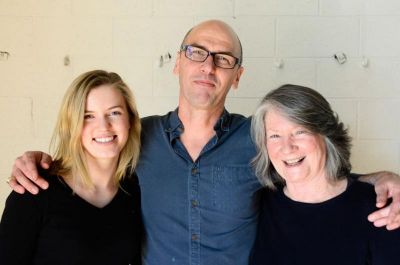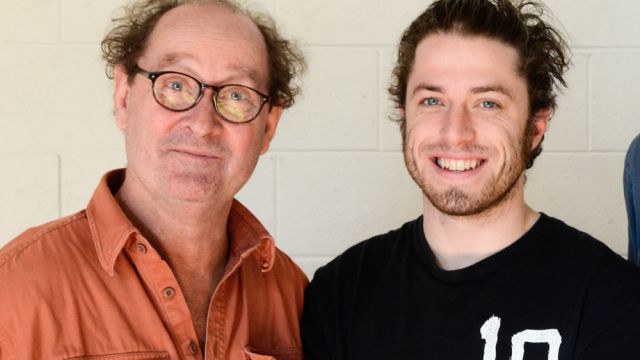The Aspirations of Daise Morrow – World Premiere
A quarter of a century after Patrick White’s death the author’s prose undergoes additional creative process as Brink Productions unlocks the theatre in one of his short story texts, creating a brutally funny and profound new play. Lesley Reed reports.
How does one acknowledge, through a theatrical work, the 25th anniversary of the death of Australian writer and Nobel Prize recipient Patrick White?
After all, White’s works were essentially brilliant prose, not drama.
What process must be undergone to not only leave the chosen prose intact but also ensure an immersive and dynamic audience experience?
This was the dilemma facing Brink Productions’ Artistic Director Chris Drummond once he’d discovered Down at the Dump, one of the stories within Patrick White’s collection of eleven short stories,The Burnt Ones.
“Down at the Dump leaped off the page as a piece that might lend itself to adaptation,” said Drummond, but he was still faced with the question of how to achieve this.
I now know that The Aspirations of Daise Morrow evolved out of the long process that followed, and that Brink Productions will present the play’s World Premiere season from 7 - 24 October at the Space Theatre in Adelaide. However, what happened within the process of the play’s development intrigued me, so I asked Chris Drummond to take me through it.
“For me the starting point was White’s story and the decision not to rewrite it,” he said. “Instantly that set up a creative tension about how to respond to the material; how to unlock the theatricality inside the text. For a while I thought it might simply be a monologue. Paul Blackwell and I spent some time working together with the story as a solo piece but came away unconvinced. However it kept nagging at me, this small domestic epic magical narrative. I couldn’t let go of the idea of staging it somehow. And then one night, lying in bed, I suddenly got an image … of a kind of music-filled installation - a cemetery, a dreamscape, a community gathering with four actor/storytellers wandering amongst the audience transporting them into White’s narrative. It came pretty strongly and I realised it was all about placing the audience inside the story somehow.”

It seems that long and restless night was indeed a catalyst; it gave Chris Drummond enough understanding to reach out to the right artists.
“I looked at the story and tried to make sense of how four actors could share the words,” said Drummond. “I settled upon the following casting attributions: Older Man, Older Woman, Younger Man, Younger Woman. I knew I wanted to work with Paul Blackwell and we both thought of Kris McQuade who had worked with us on When the Rain Stops Falling. Then I auditioned for the two younger roles to get Lucy Lehmann and James Smith. So we had our four actors.”
Of course, Chris Drummond had more to consider than securing a fine cast. Amongst a myriad of requirements, the production needed music.
“The time shifts, dreams and memories embedded in the story required a language that could transport us from one world to another in moments,” Drummond explained. “I had worked with composer/cellist Hilary Kleinig on two previous shows and felt she would be perfect. In approaching her, the idea of collaborating with her group Zephyr Quartet was born. I liked the idea of two quartets – actors and musicians – working alongside one another on the show.”
There were now a growing number of balls in the air and Chris Drummond was juggling them all! Design was just one.
“I was already working with designer Michael Hankin on another project,” said Drummond, “and knew he would be ideal for the project because of his great sense of theatre, his clear thinking, his warm, nuanced and distilled aesthetic and his tirelessly enthusiastic and generous approach to collaboration.”
And then, of course, Drummond needed to consider lighting.
“Patrick White is one the great writers for depicting light through language,” he said. “The light needed to match this. I have long wanted to work with Nigel Levings, one of our country’s great light designers. Nigel’s book shelves are filled with first editions of White’s novels. He’s lit a number of his plays as well as the opera Voss. He was the right man for the job!”
Two workshops occurred once the artists were finally in place. The first was about the text and its allocation to characters, the second with each actor taking a couple of pages in turn.
“On the last day, with everyone gathered, we read the first draft of our ‘performance’ text,” said Drummond. “All agreed that as yet we had no idea how to stage it and went to the pub!”
A few weeks later it was well and truly time to focus on the nitty gritty.
 “Hilary and I started talking about the music,” Drummond said. “We avoided talking in specific terms about the story, concentrating on the atmosphere of the piece and the sense of movement we each drew from it. We were very aware that we had text with LOTS of words and yet perhaps counterintuitively we were keen for the compositional task to be as much about long form pieces as possible; complete musical works whose integrity would remain intact inside the production. We still had no shape for imagining the show. It felt like we were coming at it purely from the inside out – together.”
“Hilary and I started talking about the music,” Drummond said. “We avoided talking in specific terms about the story, concentrating on the atmosphere of the piece and the sense of movement we each drew from it. We were very aware that we had text with LOTS of words and yet perhaps counterintuitively we were keen for the compositional task to be as much about long form pieces as possible; complete musical works whose integrity would remain intact inside the production. We still had no shape for imagining the show. It felt like we were coming at it purely from the inside out – together.”
Around the same time Michael Hankin and Drummond spent time together talking about design. Said Drummond, “It was hard to find any space inside the text through which to imagine staging images or performance moments. We both felt sure they were there somewhere but as soon as we explored an idea it would feel leaden and unnecessary given what was already being conveyed by the text. We were hunting for the smallest of cracks inside White’s narrative for some new subtext that could allow us to reveal another layer… If we were to dissolve the division between stage and audience in some interesting way then the piece might begin to exist as a theatrical concept. Michael made a few sketches of different configurations and we left it there.”
A few months later the complete artistic team came together for the second round of creative development. “This was all about the mise-en-scène,” Drummond said. “We had one week to crack the core staging/performance ideas of the piece. We gave ourselves every chance with the right studio space, a large stock of materials and props and objects, hundreds of chairs to move into different configurations, as well as technical, sound and lighting equipment. Over the week we worked as one single collective together, everyone sharing the conversation about design, performance and music, very quickly discarding anything that felt un-useful…The searching went on for a few days and we gathered moments here and there that felt like they might give us the DNA of the show. However it wasn’t until we went back to an earlier concentric configuration that we re-found the full energy and playfulness and suddenly we had our space… an egalitarian space that was neither stage nor auditorium… a community gathering, a dreamscape, a cemetery…”
 It must be wonderfully satisfying when such a Eureka moment occurs.
It must be wonderfully satisfying when such a Eureka moment occurs.
“The important thing about the process,” concluded Chris Drummond, “was that it was a moment of shared discovery and everyone in the workshop understood how this space could unlock the text, the performances and the impact and role of the music. However the truly magical discovery came on the last day when we discovered how to light it…”
And so The Aspirations of Daise Morrow was born. Set in the fictional suburb of Barranugli, the Whalley family prepare for a day at the dump, while next door, the Hogbens are getting ready for the funeral of the scandalous Daise Morrow.
Chris Drummond said, “The Aspirations of Daise Morrow is about seizing the day and not letting the bastards grind you down. It is masterful storytelling, filled with magic and wonder.”
Produced through exhilarating creative process, The Aspirations of Daise Morrow is a story about the complexities of small communities, but it also reflects the darkness and fears at the heart of society.
Starring Paul Blackwell and Kris McQuade and featuring emerging Adelaide actors James Smith and Lucy Lehmann, this immersive play includes an original score composed and performed live by contemporary Australian string ensemble Zephyr Quartet.
In the 25th anniversary of the death of Patrick White The Aspirations of Daise Morrow is surely a play not to be missed.
WHEN: October 10-24, 2015.
WHERE: Space Theatre, Adelaide Festival Centre.
TICKETS: From $38 + fees.
BOOKINGS: bass.net.au or 131 246.
DURATION: 1 hour 15 minutes, no interval. Suitable age 15+.
Images (from top): L to R: Paul Blackwell and James Smith; Patrick White; Lucy Lehmann, Chris Drummond and Kris McQuade, & Chris Drummond.
Subscribe to our E-Newsletter, buy our latest print edition or find a Performing Arts book at Book Nook.

